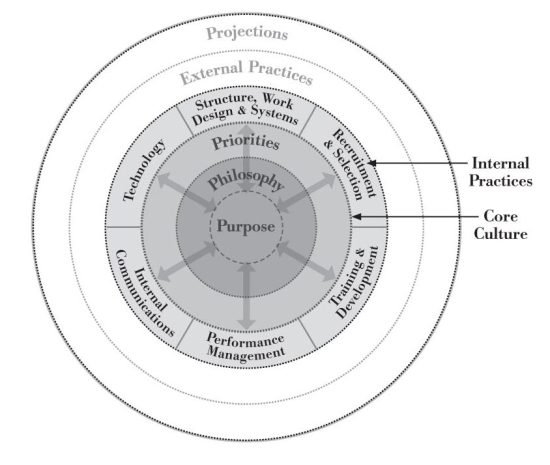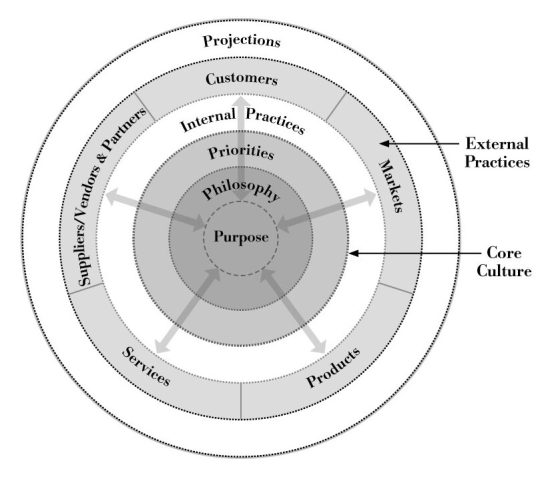Organizational Practices: behaviors, actions, habits of employees

Organizational Practices are the behaviors and actions of employees. Think of your daily work habits. Are they aligned with the values that are core to your culture?
Practices are one of the Five Ps of an organization. To clarify, the Five Ps are: Purpose, Philosophy, Priorities, Practices and Projections. As you see in the image below, there are two types of organizational Practices: Internal and External.
Purpose, Philosophy, and Priorities are the Core Culture. To explain, Core Culture is the principles and values of the organization. They are at the essence of the culture. They are the guidepost for all action.
Organizational Practices are located immediately outside of the Core Culture.
Organizational Practices are not the elements of Core Culture. Instead, they are the behaviors that convert core ideals to actions.
To sum up, Practices make the organization credible. And, they keep the culture alive.
The most effective way to live the Core Culture is to align your behaviors and actions with those core principles. Therefore, to be it, you must do it.
In a healthy organization, Practices are aligned with the principles and values of the Core Culture. That is to say, stated beliefs are the basis for organizational Practices. To sum up, ensure that Practices are congruent with the Core Culture.
Two types of organizational Practices
Organizational Practices are either Internal – affecting those within your organization – or External – with others outside the organization.
1. Internal Practices
Internal Practices are the inner workings of the organization that affect employee relationships, interactions and accomplishments. To clarify, these Practices typically affect employees.
Internal Practices are closest to the Core Culture. Therefore, the organization’s consistency in aligning these practices with the Core Culture will have a major impact on organizational success.
Internal Practices include:
- organizational structure and how you organize work, including job titles
- systems and processes for doing work
- employee roles
- work habits…that is to say, the daily habits of employees–recurring patterns for behavior
- recruitment and selection
- onboarding and the employee experience
- training, development / career development
- performance management…for example, employee goals / objectives and key results; one-on-one conversations or check-ins related to performance; performance evaluations; and recognition, appreciation, and celebrations
- internal communications…that is, communications with and among employees
- technology…to include the software and hardware used to accomplish one’s work and the use of data

Alignment of Internal Practices with the Core Culture is essential for an authentic organization. If an organization says it abides by a particular set of principles and values, then employee interactions must reflect those principles and values.
Practices include the everyday habits of employees. These habits must align with the Core Culture. If the Core Culture changes, employee roles may need to change. With those changes, there will be changes in behavior. Therefore, resulting in changes in some everyday habits. When this happens, employees demonstrate alignment with the core principles and values.
2. External Practices
External Practices define how your organization interacts with outsiders. To clarify, interaction with others who are not employees. For example, these External Practices include your customers and the markets you serve; the products and services that you offer; and your suppliers, vendors and business partners.
Above all, be sure to align these External Practices with the Core Culture. To sum up, this alignment will reinforce the Core Culture principles and create a positive impact on your business.

Organizational Practices: Summary
Core Culture principles are meaningless if you do not infuse them in these work practices. That is to say, in both Internal and External Practices.
For example, if “heartfelt caring” is a core attribute, then it is a guide for employee behavior. To clarify, it guides how they interact with each other as well as with customers. To achieve alignment, leaders should create a caring workplace and caring Practices with customers.
Or if “safety” is a core attribute, then a company must have a safe workplace. In addition, it must have Practices that ensure customer safety.
To sum up, when actions match principles, the consistency produces reinforcing behaviors that sustain those Core Culture principles.
Contact Sheila to help you align your Practices
Have any questions? To clarify, Sheila helps companies define culture, drive culture change, and increase employee engagement.
Her management consulting firm Workplace Culture Institute is located in Atlanta. And, she services clients globally.
In short, use the Contact Form to email Sheila.
